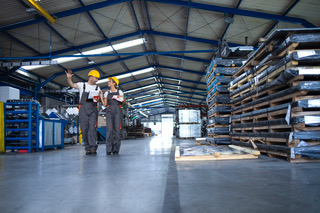 In the last three blogs, we have tried to understand automation in manufacturing and warehousing as well as its types and benefits. But, just as every coin has two sides, automation poses certain challenges. Let’s talk about those now.
In the last three blogs, we have tried to understand automation in manufacturing and warehousing as well as its types and benefits. But, just as every coin has two sides, automation poses certain challenges. Let’s talk about those now.
It is predicted that 20 million jobs will be displaced due to automation in manufacturing by 2030. This figure suggests that around 46% of jobs will be lost by 2030. Each year there is a staggering 10% increase in automation.
Lately, automation in the manufacturing sector has picked up as it reduces labor costs, increases production speed, and improves accuracy. But specific challenges still pose a threat to its guilt-free and full-scale adoption.
What are the challenges to automation in manufacturing?
There are several disadvantages of automation in manufacturing. One of the main disadvantages is the high initial investment cost. Automated machines and systems can be costly, and automation can be prohibitive for many manufacturers.
Additionally, automation can lead to job loss as machines replace human workers. Finally, automation can lead to increased dependence on technology, which can be vulnerable to malfunction or cyberattacks.
To briefly note down, the common challenges to automation in manufacturing are:
- Automating a task improperly multiplies errors
- Automation eliminates some jobs in the short-term
- Automation has a high upfront cost
- Improper use of automation leads to increased worker injuries
- Lack of skilled workforce
How can we overcome these challenges?
There are several ways to overcome the challenges of automation in manufacturing.
Upskilling – Retraining displaced workers to work with new technologies.  This can help them find new jobs and stay employed. This way, skilled workers will properly automate a task resulting in lower errors.
This can help them find new jobs and stay employed. This way, skilled workers will properly automate a task resulting in lower errors.
Financial planning – Another way to overcome these challenges is to plan better financially in the initial phase of automation. Automation has a high upfront cost, but it is a real financial game changer in the long run.
Implement standard operating procedures – Strict norms and codes should be defined to have a safe environment for workers. This will reduce workplace injuries, and a safer automation system can be designed.
Companies that overcame these challenges
Companies that have successfully implemented automation in manufacturing have typically done so by carefully planning and testing their automation systems. They have also invested in training their workers to use these systems effectively.
Taking the example of Tesla, which implemented automation in 2016 while manufacturing the Model 3. They had robots and automation almost everywhere in the production line. The new Model 3 had several upgrades, including larger battery cells. While automating, these changes were not accounted for. The automation was supposed to cut down the time by 50% for the production of battery cells. Still, it resulted in increased error rates, and manual operators had to take over before it could be redesigned.
However, Tesla learned from its previous mistakes and implemented automation correctly in 2021 in the Shanghai manufacturing plant. The Tesla giga-factory has over 445 robots automating every task with increased efficiency and skilled workers looking after them. Tesla managed to achieve the peak manufacturing limit of 45s / model y. This breaks the world record of even Ford, which was of 53s / F-150 truck.
Another example is that of Amazon. Amazon warehouses saw a jaw-dropping decline in workplace injuries due to the correct use of automation. By using automation in manufacturing at a suitable pace, providing proper guidance, and upskilling the workers to work better with automation, Amazon warehouses saw a 32% decrease in workplace-related injuries.
Conclusion
So, those are the challenges of automation in manufacturing and some ways to overcome them. As you can see, there are some challenges, but they can be overcome with careful planning and execution.
Statistical data and real-world examples show that manufacturing automation can succeed if done correctly. So don’t be afraid to try it in your own business. With proper planning and execution, you can overcome the challenges and reap the benefits of automation in manufacturing.
Stay tuned to Rucha Yantra’s Knowledge Corner as we take up a new topic next time.


